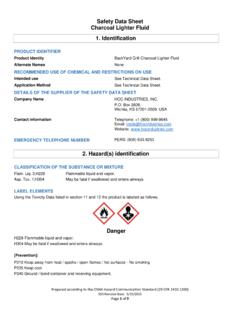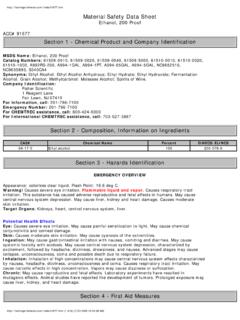Transcription of E-waste: Environmental Problems and Current Management
1 193 Review Article E-waste: Environmental Problems and Current ManagementG. Gaidajis*, K. Angelakoglou and D. Aktsoglou Department of Production Engineering and Management , School of Engineering, Democritus University of Thrace, 67100, Xanthi, 31 August 2010; Accepted 9 October 2010 AbstractIn this paper the Environmental Problems related with the discarded electronic appliances, known as e-waste, are reviewed. Moreover, the Current and the future production of e-waste, the potential Environmental Problems associated with their disposal and Management practices are discussed whereas the existing e-waste Management schemes in Greece and other countries (Japan, Switzerland) are also.
2 E-waste Management , Environmental pollution, of Engineering Science and Technology Review 3 (1) (2010) 193-199 JOURNAL OFEngineering Science and Technology the last years, there is an increasing acknowledgment of our impact on the environment due to our lifestyle, while the need to adopt a more sustainable approach concerning our consumption habits emerges as of particular significance. This trend regards in-dustrial sectors affecting the consumption habits and, especially, electronic industry where the short life cycles and the rapidly de-veloping technology have led to increased e-waste volumes.
3 The majority of e-waste elements are led to landfills. However, their partial recyclability, due to their material composition along with the unavoidable restrictions in landfills, has led to the development of retrieval techniques for their recycling and re-use, highlight-ing the significance of e-waste recycling, not only from a waste Management aspect but also from a valuable materials retrieval is often misinterpreted as related to old computers or IT equipment in general, while the synonymous term Waste Electrical and Electronic Equipment (WEEE) is also used in the international literature.
4 Several e-waste definitions are summarized in Table 1. Summary of selected e-waste definitions. ReferenceTerm-definitionEuropean Directive 2002/96/EC Waste electrical and electronic equipment, including all components, subassemblies and consumables which are part of the product at the time of discarding . The Directive 75/442/EEC, Article I (a), defines as waste any substance or object which the holder discards or is required to discard in compliance with the national legislative provisions .Basel Action Network( ) E-waste includes a wide and developing range of electronic appliances ranging from large household appliances, such as refrigerators, air-conditioners, cell phones, stereo systems and consumable electronic items to computers discarded by their users.
5 OECD( ) Any household appliance consuming electricity and reaching its life cycle end .In this article, e-waste and WEEE are considered synony-mous and include the 10 categories provided for by the Directive 2002/96/EC on e-waste (Table 2).Table 2. E-waste categories pursuant to the EU Directive 2002/96/EC. NoCategoryLabel1 Large household appliances Large HA2 Small household appliancesSmall HA3IT and telecommunications equipmentICT4 Consumer equipmentCE5 Lighting equipmentLighting6 Electrical and electronic tools (with the excep-tion of large-scale stationary industrial tools)E&E tools7 Toys, leisure and sports equipmentToys8 Medical devicesMedical devices9 Monitoring & control instrumentsM&C10 Automatic dispensersDispensers * E-mail address: 1791-2377 2010 Kavala Institute of Technology.
6 All rights reserved. 1. Introduction194E-waste differs chemically and physically wise from urban or industrial waste. It contains both dangerous and valuable materi-als requiring special treatment and recycling practices to avoid ad-verse Environmental impact and harmful impact on human health. Retrieving the valuable and base metals is possible by recycling e-waste, but the high labour cost and the strict Environmental leg-islation have consolidated these activities implementation mostly in Asian countries such as China and India [1] by use of obso-lete methods and inadequate emphasis on the employees protec-tion [2].
7 As a result, the e-waste disposal issue has attracted the interest of politicians, non-governmental organizations, such as Greenpeace ( ), Basel Action Network ( ), Silicon Valley Toxics Coalition ( ) and the scientific E-waste Current SituationThe global e-waste production is assessed at 20-50 Mt/year [3], equal to 1-3% of the estimated global urban waste production (1636 Mt) [4, 2]. PCs, cell phones and TVs will contribute Mt in 2010 and will amount to Mt in 2015. In wealthier countries, e-waste will stand for 8% of the urban waste volume [5]. Each electronic item s participation in the annual e-waste production, E (kg/year), depends on each electronic item s mass, M (kg), its quantity (number) in the market and consumption, N, and its aver-age life cycle, L (year).
8 E = MN/L (1)Electronic computers with an average 3-year life cycle [6] contribute to a greater extent to the total e-waste flow compared to refrigerators and electrical cook-stoves, having an average life cycle of 10-12 years. Certain e-waste types along with their mass and estimated life cycle are summarized in Table for the European Union, the e-waste quantities increase by 3-5% per year [9], a rate three times faster than the urban solid waste. During the 1990-1999 period the quantities pro-duced in EU-15 were approximately kg/resident, while es-timated quantities for the 2000-2010 period vary between kg/resident [5].
9 Using the equation (1), Swiss is estimated to pro-duce 9 kg/person/year [10], the European population 14 kg/person/year [11], with the total EU-15 production amounting to Mt/year and, in case of EU-27, Mt/year [12]. USA produced approximately Mt [2], while China produced Mt in 2005 [13]. There are no available data for poorer countries, but it was as-sessed that India and Thailand produced and Mt of e-waste in 2007 [2].According to another calculation based on the equation (1), and available data for the total number of PCs ( billion units), cell phones ( billion units), stationary phones ( billion units), TVs ( billion units), and radios ( billion units), the total production amounts to Mt/year [7].
10 Moreover, consider-ing the constantly increasing production of e-waste and the fact that the relatively large-mass electrical appliances (refrigerators, air-conditioners etc.) are not included in the aforementioned calcu-lation, it is estimated that the total e-waste quantities will be rather larger. If the global increase of GDP by approximately 20% in the last 6 years is also considered, then the aforementioned estimate of 20-50 Mt/year [3] is 3. E-waste types and their estimated life cycle. ItemMass of Item (kg)Estimated life (years)Personal Computer (PC)a253 Fax machineb35 High-fidelity systemc1010 Cell phonec gamesc35 Photocopierb608 Radioc210 Television (TV)d305 Video recorder/DVD Playerc55 Air-conditionerb5512 Dish washerc5010 Electric cookerc 6010 Food mixerc15 Freezerc3510 Hair-dryerc110 Ironc110 Kettlec13 Microwavec157 Refrigeratorc3510 Telephonec15 Toasterc 15 Tumble Dryerc3510 Vacuum cleanerc1010 Washing machinec658a [6], b [7], c [2], d [8].









